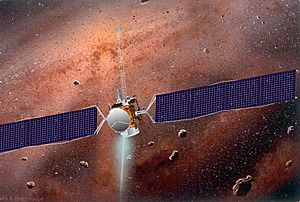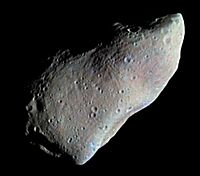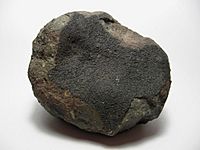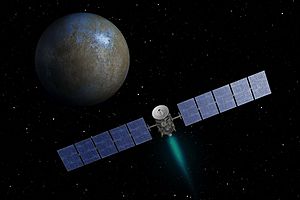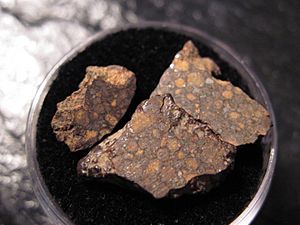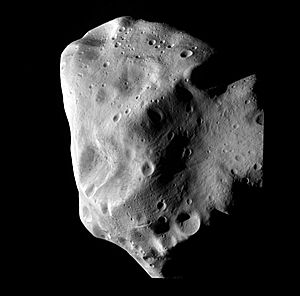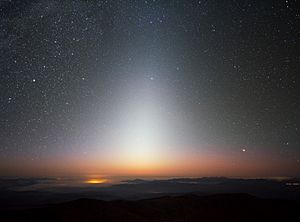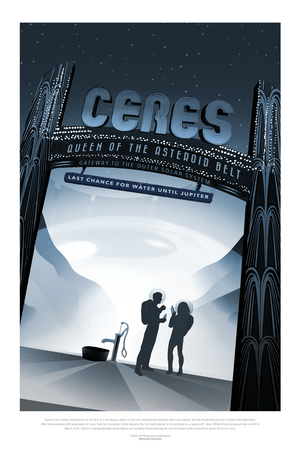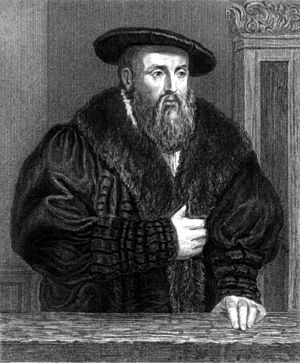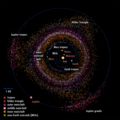Asteroid belt facts for kids
The asteroid belt is a huge, donut-shaped area in our Solar System. It's found between the orbits of the planets Mars and Jupiter. This area is also called the main asteroid belt to tell it apart from other groups of asteroids.
The asteroid belt is filled with many oddly shaped space rocks called asteroids or minor planets. You can't see them with just your eyes from Earth. But you can spot many of them using binoculars or small telescopes.
Contents
How the Asteroid Belt Formed
The asteroids we see today are not exactly how they were when the Solar System first began. They have changed a lot over billions of years. They've been heated from the inside, melted by impacts, and hit by tiny space dust.
The asteroid belt started from the cloud of gas and dust that formed our Solar System. This cloud created tiny building blocks called planetesimals. These planetesimals were like small seeds that could have grown into planets.
However, Jupiter's strong gravity played a big role. It pulled on these planetesimals between Mars and Jupiter. This made them move too fast and crash into each other too hard. Instead of sticking together to form a planet, they broke apart.
Because of these powerful collisions, most of the original material in the asteroid belt was lost. About 99.9% of its mass disappeared in the first 100 million years. Some of these broken pieces ended up traveling into the inner Solar System. This caused meteorite impacts on planets like Earth.
Scientists from the University of Florida suggested in 2018 that the asteroid belt might have formed from the leftover pieces of several ancient planets that shattered.
What Are Asteroids Like?
Even though there are many asteroids, the asteroid belt is mostly empty space. The asteroids are spread out over such a huge area. It would be very hard to hit one without aiming carefully.
Still, hundreds of thousands of asteroids are known today. Scientists think there could be millions more. Over 200 asteroids are larger than 100 kilometers (about 62 miles) across. A study suggests there are between 700,000 and 1.7 million asteroids that are 1 kilometer (about half a mile) or larger.
More than 96,000 asteroids have been given numbers. Almost 12,000 of them have names. People who discover new asteroids can suggest names for them. But because so many are found now, most new asteroids just get a numbered code.
The total mass of all the asteroids in the belt is only about 4% of the mass of Earth's Moon. The four largest objects hold half of the belt's total mass. These are Ceres, 4 Vesta, 2 Pallas, and 10 Hygiea. Ceres alone makes up almost one-third of the belt's total mass.
Ceres is the only dwarf planet in the asteroid belt. It is about 950 kilometers (590 miles) wide. Vesta, Pallas, and Hygiea are all less than 600 kilometers (370 miles) wide. In 2014, scientists found water vapor on Ceres for the first time.
The other objects in the belt range from large rocks down to tiny dust particles. Spacecraft have traveled through the asteroid belt many times without any problems. This shows how spread out the material is.
However, large asteroids do sometimes crash into each other. These collisions can break an asteroid into many smaller pieces. This creates an asteroid family with similar orbits and makeup.
The temperature in the asteroid belt changes depending on how far an asteroid is from the Sun. For dust particles, temperatures can range from -73°C (-99°F) closer to the Sun to -108°C (-162°F) farther out. An asteroid's surface temperature also changes a lot as it spins. One side gets sunlight, while the other faces the cold of space.
What Asteroids Are Made Of
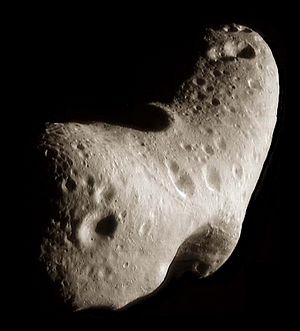
The asteroid belt mainly has three types of asteroids:
- C-type asteroids (carbon-rich): These are full of carbon. They are found mostly in the outer parts of the asteroid belt. They make up over 75% of all visible asteroids. They look redder and don't reflect much light. Their surface is similar to carbon-rich meteorites.
- S-type asteroids (silicate-rich): These are more common closer to the Sun. Their surfaces show silicates (rocky materials) and some metal, but not much carbon. This means their materials have changed a lot since they formed, possibly from melting. They make up about 17% of all asteroids.
- M-type asteroids (metal-rich): These make up about 10% of all asteroids. They contain elements like iron and nickel.
About three out of four asteroids are made of carbon-rich rock. The rest are made of metals like iron and nickel. Some are pure metal, while others are mixed with rocky compounds. The larger metal asteroids hold huge amounts of iron, much more than is mined on Earth each year. Vesta, the brightest asteroid, is unusual because it's made of dense volcanic rocks.
Scientists are very interested in what asteroids are made of. This helps them learn how our Solar System was formed. Many spacecraft have visited asteroids to study them up close.
Asteroid Collisions
The asteroid belt is a busy place, so asteroids often crash into each other. Collisions between large asteroids (about 10 km wide) happen about once every 10 million years.
A collision can break an asteroid into many smaller pieces. This can create a new asteroid family. Sometimes, if asteroids crash at slow speeds, they can even join together. After more than 4 billion years of these crashes, the asteroids in the belt look very different from when they first formed.
Besides asteroids, the belt also has bands of dust. This fine dust is made when asteroids crash into each other or when tiny meteorites hit them. The pressure from sunlight slowly pushes this dust inward toward the Sun.
Some of the pieces from collisions can become meteoroids. These meteoroids can enter Earth's atmosphere. Of the 50,000 meteorites found on Earth, 99.8% are thought to have come from the asteroid belt.
Exploring the Asteroid Belt
The first spacecraft to travel through the asteroid belt was Pioneer 10 in 1972. At that time, scientists worried that the spacecraft might be hit by debris. But since then, 12 spacecraft have safely passed through the belt without any problems. Pioneer 11, Voyagers 1 and 2, and Ulysses all went through the belt without taking pictures of asteroids. Juno also traveled through the asteroid belt on its way to Jupiter. Because the material in the belt is so spread out, the chance of a probe hitting an asteroid is less than 1 in a billion.
Many spacecraft have taken pictures of asteroids during quick flybys on their way to other places:
- Galileo imaged Gaspra in 1991 and Ida in 1993.
- NEAR imaged Mathilde in 1997 and landed on 433 Eros in 2001.
- Cassini imaged Masursky in 2000.
- Stardust imaged Annefrank in 2002.
- New Horizons imaged APL in 2006.
- Rosetta imaged Šteins in 2008 and Lutetia in 2010.
Only a few missions have actually orbited and studied asteroids for a longer time. The Dawn spacecraft orbited Vesta from 2011 to 2012. It has been orbiting Ceres since 2015. The Hayabusa mission also studied an asteroid from orbit and even collected samples.
How We Discovered the Asteroid Belt
In 1596, a scientist named Johannes Kepler thought there might be a planet between Mars and Jupiter. He noticed a big gap between their orbits. When William Herschel discovered Uranus in 1781, astronomers became even more sure that a planet must exist in that gap.
On January 1, 1801, Giuseppe Piazzi, an astronomer in Sicily, found a tiny moving object. He named it "Ceres" after a Roman goddess. Piazzi first thought it was a comet. Ceres is the largest object in the asteroid belt. For many years, Ceres was called a planet. Later, it was reclassified as an asteroid. In 2006, it was named a dwarf planet.
About 15 months later, Heinrich Olbers found a second object in the same area, called Pallas. These objects looked like stars but moved quickly. By 1807, two more objects were found: Juno and Vesta. These are now classified as asteroids.
The name "asteroid belt" started being used in the early 1850s. By 1868, 100 asteroids had been found. In 1891, using astrophotography (taking pictures of space), helped astronomers find new asteroids even faster. By 1921, 1,000 asteroids were known. By 1981, there were 10,000, and by 2000, 100,000. Today, special computer systems automatically find new minor planets all the time.
Images for kids
-
Johannes Kepler noticed in 1596 irregularities in the orbits of Mars and Jupiter, which were later explained by the gravity from the asteroids.
-
Giuseppe Piazzi, discoverer of Ceres, the largest object in the asteroid belt: Ceres was known as a planet, but later reclassified as an asteroid and from 2006 as a dwarf planet.
-
Hubble views extraordinary multi-tailed asteroid P/2013 P5.
-
Overview of the Inner Solar System asteroids up to the Jovian System.
See also
 In Spanish: Cinturón de asteroides para niños
In Spanish: Cinturón de asteroides para niños


